
Reference Architecture for Team AI Productivity
Patterns for building enterprise grade AI web chat portals
Let's discuss a sample reference architecture for providing a secure and convenient way for your organization to chat with pre-approved AI capabilities.
Previously in this series we discussed Website RAG Chat and Developer AI Productivity reference architectures. Those architectures are valid and helpful for delivering rich AI capabilities to your customers and developer team, but what about the rest of your organization?
In this article we'll lay out a reference architecture that allows different members of your organization to safely enhance their workflows through AI, and do so with the knowledge that organizational data is being handled securely and intellectual property is being respected.
While this architecture could work using a variety of different technologies, specific examples and screenshots will feature the popular Open WebUI conversational AI platform.
Use cases
You may not immediately think that providing a team-wide AI system would be extremely helpful, but when we unveiled our "Chat EDJE" conversational AI solution at Leading EDJE we noticed some immediate and profound impacts on our teams for all types of users.
While developers were excited about these capabilities and took advantage of them for complex tasks like working on improving SQL performance by comparing a complex query with an execution plan, we also saw some tremendous benefits for non-developers.
We saw project managers gain access to ways to generate new ideas relevant for the teams they were on, web designers able to gain access to specialized insights for technical search engine optimization (SEO) considerations, analysts able to help quickly find and fix anomalies in data, and all team members benefitted from summarization and email drafting / proof checking capabilities.
While we weren't initially sure that AI tooling would truly help all team members, we continue to be blown away by the impact of secure, reliable, AI tooling applied to the entire organization and governed by the organization's IT staff.
Let's talk about how this works.
A sample architecture
A team productivity conversational web AI chat architecture consists of the following required components:
- A web chat portal for hosting the conversations
- One or more registered model provider that makes public or private conversational AI models (typically LLMs) available to the team
- A management layer allowing administrators to configure and control the model
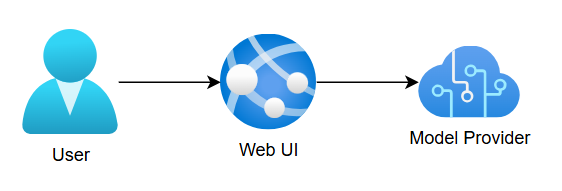
Conversational web AI chat architectures may also include the following optional components:
- A persistence layer for storing past conversation sessions
- A context layer that provides additional documents, tools, or capabilities that can augment the conversation
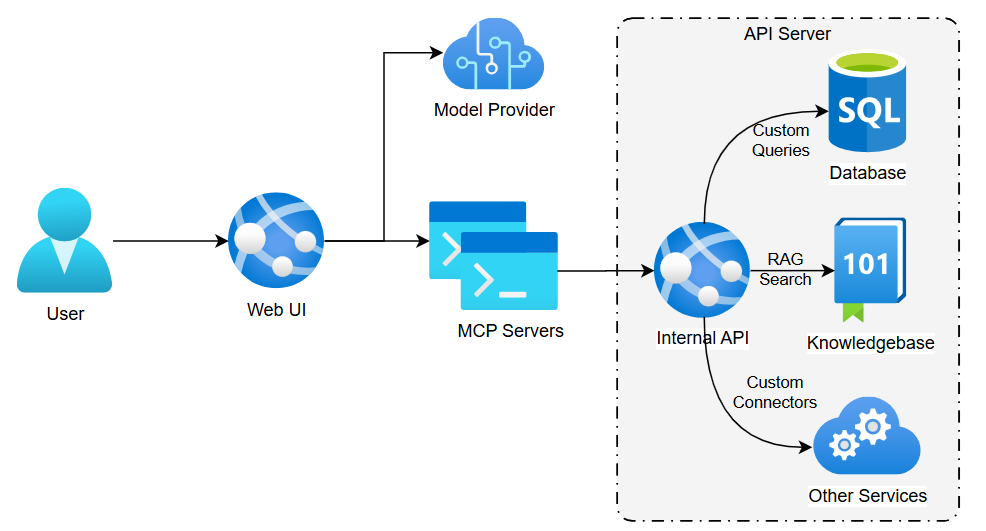
Let's walk through each of these required and optional components, talk about what they are and the various choices you might need to make with each one.
Web Chat Portal
The first component is the most obvious: you need a centralized web chat portal where users can go to ask questions of your system. This typically looks like a web page hosted on your organization's intranet or on the internet and is secured via your organization's preferred authentication options.
The web chat portal allows you to select a prior conversation to continue (if a persistence layer is present) or start a new conversation.

When starting a new conversation, users must select a model to interact with from the approved list of models, specify a textual query / prompt, and optionally include documents, files, or web links to act as additional sources of context before sending the message.
Your web chat portal may stream the completions your model provides so the user can see the response in real-time, but once the response is fully complete it should show up in your portal and include additional context, links, and feedback mechanisms.
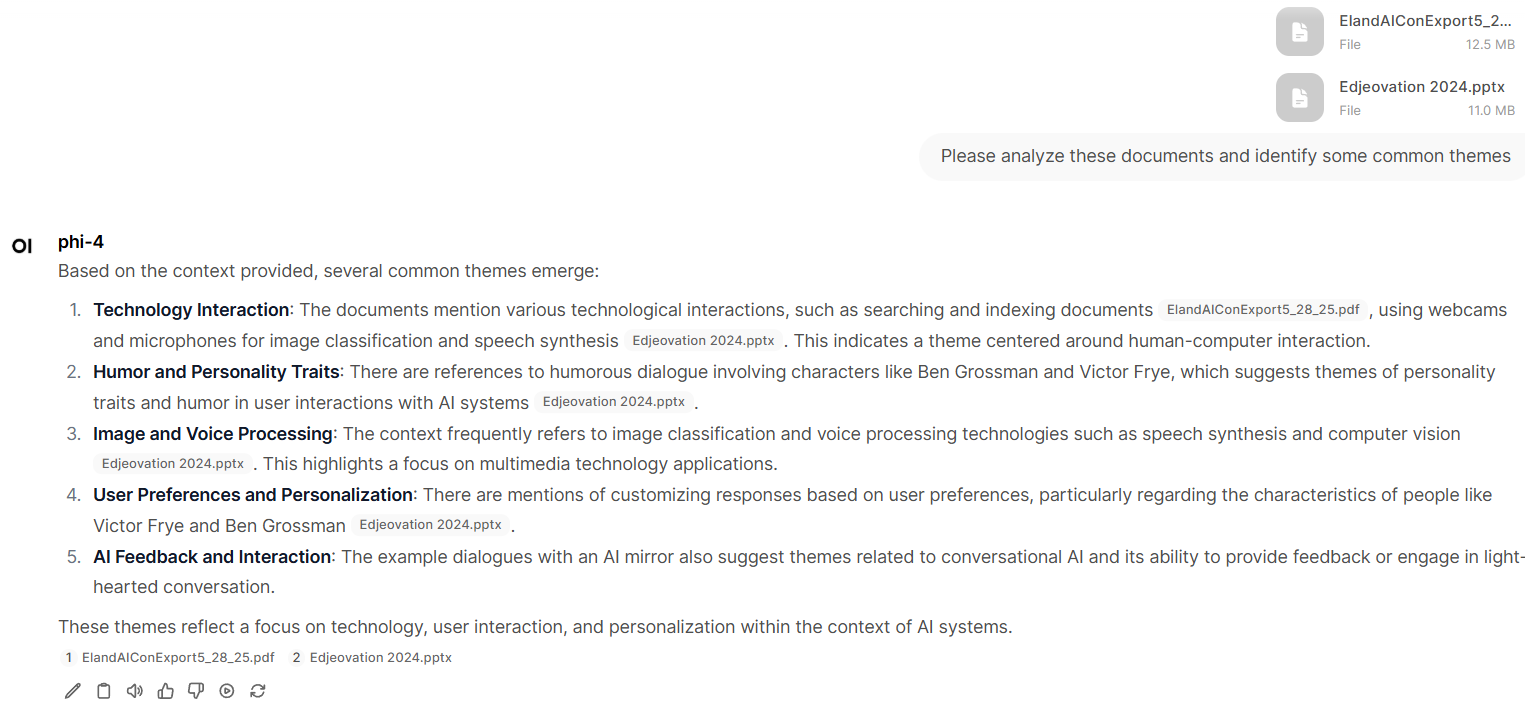
Some web chat portals may also support asking the same question of multiple models to compare their responses or may give you the ability to edit your existing messages and resend them to regenerate a response.
It's important to know that when a persistence layer is present, entire interactions with the system may be stored temporarily or permanently for auditing or quality control purposes. This is particularly true when users provide positive or negative feedback. As a result, users should be informed that their conversations may be stored and retrieved by your organization's IT staff or potentially other personnel and the system should therefore be treated with the same level of professionalism as you would expect from a communications platform like Slack, Teams, or Discord.
Model Provider
A model provider is a connector that connects your web chat portal to organizationally approved large language models (LLMs) that users are allowed to interact with.
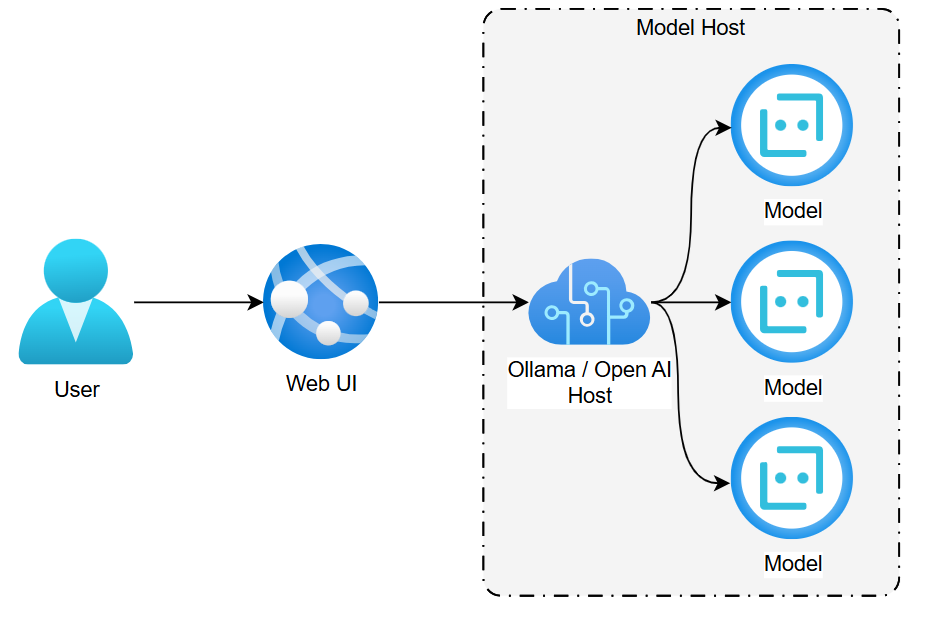
Your organization may use public models like those deployed on OpenAI, instanced / dedicated models hosted on a service like Azure, or your team may self-host models using something like Ollama or LM Studio. Your team could even use a combination of these by specifying multiple model providers.
Your list of approved models will grow and shrink over time as new models arrive, are reviewed and approved, and as older models get retired and replaced with newer ones. The most important thing to remember with your model selection is that you only list models your organization is comfortable with people using. If a model does not meet your organization's IP security needs (for example, it retains logs for training future models), it should not appear in your list of models to your end users. In this way, users working with your solution know that they are in compliance with organizational AI policies.
You may wonder "why don't organization's just use a single approved model? Why give user choices?". While providing choices to users may raise the barrier to entry slightly for some users, the overall benefits of having different models is usually worth it. Because different models are good at different tasks and have different basic characteristics in terms of speed, accuracy, and cost, it can be helpful to allow your users to choose.
Additionally, you may find that some models temporarily go offline - particularly if you're using multiple model providers - and it can be helpful to have backup resources for people to consider.
Management Layer
Most AI chat solutions have some form of management or configuration associated with them. The management layer allows your IT admin team to configure your web chat system and connect it to various models and other providers.

Once model providers are configured, you can also select the various models from your model providers that should be available to your users:

Organizations using pay-per-usage models can sometimes use the management layer to limit the budget of individual users in order to ensure a predictable maximum expense per week per user limit.
Persistence Layer
Most web portals with a management layer will also have some form of a persistence layer that allows storing past conversations. This is done for convenience for users who which to refer to past conversations or resume them and can also help your organization's IT team manage and monitor its AI infrastructure.
In evaluating models and compliance, admins may be able to see some or all of the private interactions with users, depending on how the persistence layer is configured and if any rolling delete or anonymization capabilities are present. While this helps evaluate which models are actively being used and how they're performing, this capability and how it may be used should be disclosed to your employees as some employees may include context they intended to be private in even legitimate interactions with the system. For example, an employee brainstorming a presentation with an LLM may choose to disclose private medical information about physical or mental conditions that might impact their performance in order to perform their company-assigned tasks more effectively.
Your persistence layer could be as simple as a series of configuration files, or it could be a relational or document database. Some persistence layers may even use a vector store to store text embeddings allowing for searching past conversations or indexed documents. The capabilities of your persistence layer vary based on the overall solution you're using and will be strongly tied to whatever solution you choose.
Context Layer
Perhaps the most exciting of all the parts of an AI solution is the context layer. The context layer is able to provide your LLM with additional knowledge and capabilities including:
- Tools / functions that can be called to produce a result. Some tool examples might involve checking current weather in an area, tracking a package that's out for delivery, or searching the internet.
- Prompts define common text instructions for carrying out a task in a way that helps multiple people on your team
- Resources such as documents, web pages, and additional pieces of information that can help provide additional context.
These capabilities are typically integrated using a standardized format like Model Context Protocol or OpenAPI endpoints.
When a user sends a request to the LLM, these additional capabilities will also be sent along to the LLM and it may choose to take advantage of them in order to fulfill the user's request. This makes these additional capabilities a form of a retrieval-augmented generation (RAG) data source.
By integrating additional tools and capabilities into your AI systems, you are offering unique value for your organization that they cannot find in another tool. These capabilities are your unique way of adding in additional context to your organization that will help employees do their jobs more effectively. This context can include:
- Tools of looking up the status of different work items, orders, or customers
- Resources documenting standard definitions, systems, and workflows
- Prompts that help generate output that's consistent with organizational branding or work standards
In short, the context layer is something that is uniquely yours and can be uniquely controlled by your organization.
These capabilities can be so valuable that some organizations even offer a shared architecture that encapsulates these tools into a MCP server that is shared between the web AI chat tooling and individual developer productivity solutions as shown here:
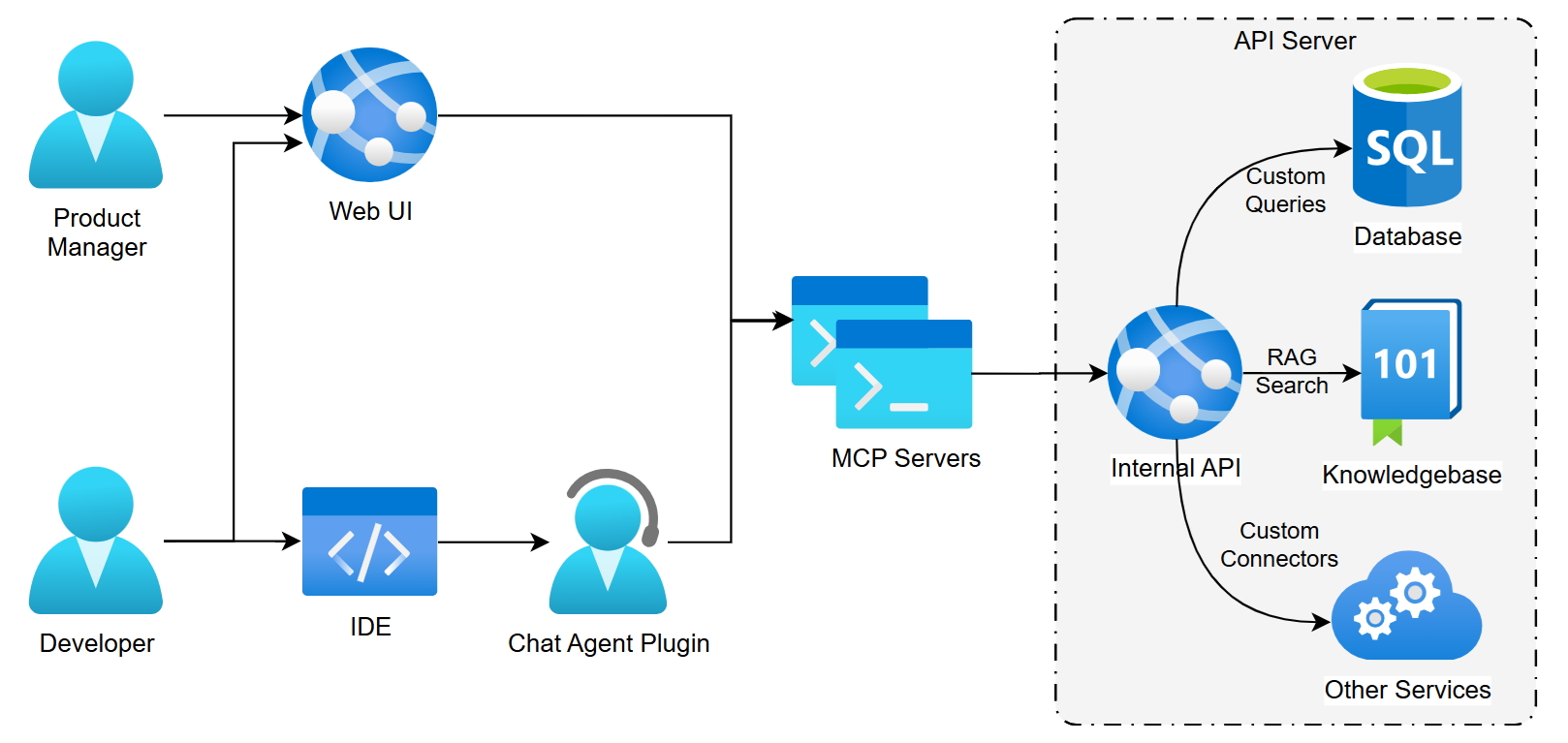
In this way all employees can take advantage of organizational knowledge, standards, and capabilities when performing their work, regardless of what that work entails.
Additional Integrations
Some web AI chat systems may include additional integrations including:
- Text to speech capabilities that read aloud responses from the system
- Speech to text capabilities that allow you to talk to your LLM
- Image generation via ComfyUI, OpenAI, Gemini, or other providers
- Web search capabilities (essentially a built-in tool provided by your platform)
- Direct code execution capabilities in sandboxed environments
This list of capabilities will vary depending on what web chat provider you selected and will change over time as industry trends evolve.
Securing your chat provider
While providing your users with a curated list of models is fantastic for helping users interact with AI in approved ways, these same capabilities can be a target for attackers as well.
If you do not properly secure your AI web chat capabilities it is possible that an attacker can discover your endpoint and use it to cause damage such as:
- Incurring charges against pay-per-use AI models
- Conduct a denial of service attack against your AI models by attempting to exhaust your rate limit capabilities for certain LLMs, denying legitimate users access to these resources
- Access sensitive information stored in prompts or resources
- Exploit tools to perform additional attacks such as searching your knowledgebase, querying data stores, or other actions dependent on the exact nature of your implemented tools
There are a number of ways of remedying these vulnerabilities including:
- Properly researching the various web AI chat providers to ensure they meet your security and administration needs
- Requiring users to log in via an API key, LDAP, or some other form of authentication
- Configuring firewall rules to require a VPN to access AI tooling
- Setting sensible rate limiting or access permission on groups of users so a single compromised user cannot inflict massive damage to the organization
While any new system carries new attack vectors for malicious users, one of the realities of a world where AI tools are ubiquitous is that your users will find AI tooling that meets their needs. Your goal as an organization should be to make sure that when they do this, they do it in an approved way that also meets the organization's data stewardship and security needs.
Conclusion
Conversational AI systems are powerful ways of augmenting your entire team's capabilities, and a web AI chat portal is an effective way to provide a secure means for your organization to innovate with AI in approved and cost-effective ways. What's more, the ability to integrate your organization's context through resources, prompts, and tools is an offering that no other AI chat toolset will provide - and it can be easily integrated into other solutions such as developer AI productivity architectures.
We've been amazed at the things our team at Leading EDJE has been able to do with properly governed AI - both internally and for our clients - and we'd love to discuss how you can move forward with AI.